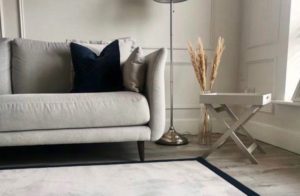No products in the cart.
Rugs are more than just decorative pieces. They tie a room together, provide comfort underfoot, and bring warmth to various parts of your home. However, not all rugs are created equal, and the choice of rug material plays a pivotal role in determining the rug’s quality, durability, and overall performance.
In this rug material guide, we will explore different materials, and help you make an informed decision when choosing the best quality rugs for your home.
Before we dive into the specifics of how to choose rug materials, it’s important to remember that rugs come in a wide array of materials, each with its own unique characteristics. Determining which rug material is best requires you to understand the available options:
Wool rugs are renowned for their luxurious texture and exceptional durability and are often some of the best quality rugs on the market. They provide excellent insulation, making them perfect for the colder climate we experience. Wool rugs are also known to maintain their shape and beauty over time. But not only that, wool is exceptionally easy to clean, making this material a popular choice for many households.
Synthetic materials like nylon, viscose, polyester, and polypropylene offer a more budget-friendly option. These rugs are highly stain-resistant and come in a wide range of colours and styles. While they may not have the natural feel of wool, they are a practical choice for high-traffic areas.
Sisal, jute, and seagrass rugs fall into the natural rug materials bracket. These rugs add a touch of rustic charm to your home and are best suited for low-traffic areas. They are eco-friendly and biodegradable, making them an excellent choice for the environmentally conscious.
Cotton rugs are soft and affordable. They are easy to clean and come in a wide range of patterns and colours. This makes them a great option for homes with children and pets.
Silk rugs are the epitome of luxury. They have a soft, silky texture and a beautiful sheen. While they are incredibly luxurious, they require careful maintenance and are best suited for very low-traffic areas. Silk rugs are more of a statement piece than a practical floor covering.
If you’re looking for a rug to place in outdoor settings, consider materials like polypropylene or polyester. These rug materials are resistant to moisture and fading, ensuring your outdoor rug remains in top condition.
Tufted rugs are created by punching yarn through a fabric base (rug tufting), resulting in a looped or cut pile. They are versatile and come in various materials, allowing you to choose a tufted rug that suits your preferences.
Blended rugs combine different materials to harness the advantages of each. For example, a wool and synthetic blend can offer the softness of wool with the stain resistance of synthetics.
Now that you have an overview of different rug materials, let’s look at what to consider when choosing the best quality rug for your needs.

Selecting the best quality rug material really depends on where you intend to place the rug. Here’s a breakdown of the most suitable materials for different settings:
For the living room, consider soft and comfortable materials like wool, cotton, or synthetic blends. They will provide you with a cosy atmosphere and withstand regular foot traffic and maintain their appearance over time. These are also some of the safest rug materials and will not slip as much.
For a cosy bedroom, opt for a soft and comfortable rug material like wool or silk. These materials will provide warmth and comfort underfoot and are comfortable to sit or lie on.
Stain resistance is essential in the dining area. Synthetic rugs or natural rug materials fibers like jute or sisal are good options as they can handle spills and heavy furniture. Another quick rug tip – be sure to choose a rug with a low pile here to facilitate chair movement.
Given the potential for spills and stains, go for easy-to-clean materials such as synthetic or cotton rugs. Additionally, outdoor rugs can be a practical choice for kitchen spaces.
Wondering what material outdoor rugs are made from? Well, they should be made from weather-resistant materials like polypropylene. These can withstand rain and sun exposure without losing their vibrant colours. More fragile materials should not be used outside.
For areas with heavy foot traffic, like hallways and landings, consider wool or synthetic rugs. Wool is durable and will maintain its appearance over time, while synthetic materials are stain-resistant and easy to clean.
If you’re aiming for sheer luxury, and have no budget constraints, consider these luxury rug materials:
When choosing a rug material, it’s important to assess its quality to ensure you’re getting the best value for your money. Here are some key factors to consider:
Quality rugs are typically denser, with more knots per square inch. You can check the density by simply pressing your fingers into the rug. If you can feel the backing easily, it may not be of the highest quality. But the best way to ensure your rug will last is to talk to an expert.
Synthetic materials rugs are typically more stain-resistant, often having built-in stain protection. Wool and silk rugs may require regular professional cleaning to maintain their beauty.
Wool and synthetic materials are the most durable options. They can withstand heavy use and are less likely to show signs of wear and tear. Natural fibre rugs may not be as long-lasting.
Some materials may not be suitable for all situations. For instance, olefin and viscose can be delicate and a less reliable choice. Poorly made rugs with loose edges or backing issues should always be avoided to ensure a longer lifespan for your investment. A rug with quality rug backing material, like the options available from us here at Matt Britton, is a must.
Expensive rugs are typically made from the best quality materials and are handcrafted with intricate designs. They are more dependable and feature fine details that set them apart.
Rugs come at a wide range of price points. Higher-quality materials and construction methods will cost more. While it may be tempting to opt for a cheaper rug, investing in a high-quality one can save you money in the long run, as it will likely last longer and maintain its appearance. Cheap rugs may look appealing initially, but they might wear out quickly and lack the durability and style of a high-quality rug.
The lifespan of a rug can vary widely based on material and maintenance. Here’s a rough estimate for different types of rugs:
However, it is proper care and maintenance that significantly extends the life of your rug across most materials.
High-quality rugs are those made from premium materials and crafted with skill and attention to detail. These rugs are known for their durability and often come with a higher price tag.
Rugs can be made from a variety of fibres, including wool, synthetic materials, natural fibres like jute and sisal, silk, and even exotic fibres like alpaca and Mongolian cashmere.
Synthetic rugs, like those made from polypropylene or nylon, are rug materials easy to clean. Wool rugs are naturally stain-resistant and also relatively easy to maintain with regular care.
Wool and silk rugs are some of the most comfortable options due to their softness and plush feel. High-pile rugs also tend to be more comfortable underfoot.
If you’re looking for a custom rug that perfectly matches your vision, consider Matt Britton. With a keen eye for materials and design, our experts can help you create the rug of your dreams, ensuring that it complements your space and lifestyle.
Take a look at our user-friendly rug builder or book an appointment with one of our experts today.
